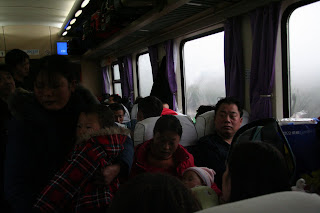

Beijing's one of those hilarious cities with countless, fascinating layers of history that have been systematically razed to the ground by centuries of conquering regimes, only to have its latest leaders realize, a couple of decades ago, "Oh crap, guys--we need something to show the tourists."
As a result, you can check out ancient, culturally rich places like the Forbidden City, the Drum Tower and a dizzying array of temples to marvel at the brightly coloured, meticulously restored architecture and the total lack of anything actually all that, um, old.

All these places have been plundered by previous generations, including in some cases the predecessors of those who've gone to incredible lengths to restore and prettify 'em for the hordes of tourists that flock to their doorsteps. 非常 有意思。

The Forbidden City is a really good example of this. I'm not sure if it's Beijing's most oft-visited landmark, but it certainly feels that way as you push your way through hordes of crowds to get a glimpse of the various freshly painted buildings that, captions assure, once housed the emperor and his kitchen, harem, temple and courtiers in the verboten heart of the Chinese empire. There are precious few original artefacts from any of these sanctums, however; many were destroyed in a fire in the early 20th century and others were taken by the Guomindang on the party's way to Taiwan in 1949; others just weren't preserved after the Qing fell. But the buildings are purty.
One intruiging thing about the sightseeing hordes, though, is that the majority (or at least the plurality) of them are Chinese who've made the trek out from other provinces to ooh and ahh at these national icons and wait in line for hours to put a rose near Mao Zedong's meticulously preserved corpse. While they're posing in front of various landmarks, they also snap photos of the exotic foreigners wandering around.

My first attempt to check out Tian'anmen Square proved a total failure--the biggest "public square" in the world is closed from 6 p.m. to 6 a.m. When it is open, the crowds who flock to wander its concrete pavestones and pose for photos in front of the ginormous Mao Zedong portrait across the street hanging from the Tian'an Men have to pass first through a security checkpoint, complete with an X-ray machine and stern, uniformed guards posted at each of the square's intersections. I saw several military patrols, decked out in green fatigues, marching to and from the area.
Tian'anmen Square was built originally to convey a sense of the Communist Party's enormity. It succeeds, but perhaps not in the way Mao intended.
Equally cool and much more intimate are the city's hutongs--narrow alleyways lined by small grey brick houses that date to the Mongol period (many of the ones still standing have been restored so the tuk-tuk drivers can tour hapless foreigners around them). I met a family from Shanxi province that came to Beijing to run a noodle shop. Of course they miss their home province, they said. But leave the capital? Not a chance.

Most of the city's migrants, however, still haven't returned since they were cleared out before the Olympics. The ubiquitous banners, buildings and security overkill remain as a visible legacy to the games. For all the ads plastered around this city, you'd think the Olympics were still going on. Except, of course, for the glut of cars zipping through the downtown core. No more even-odd switching for jet-setting Beijingren.

I didn't expect the Great Wall to be a highlight. The name itself is so oft-repeated by tourists and would-be tourists that it has passed almost beyond cliche into the realm of larger-than-life mythology.
But we decided that even if we gave in to the myth and made the trek out to the country's most famed tourist attraction, we were going to go in through the back door. We caught a public bus out to the Beijing suburb of Miyun, knowing nothing except that this city was close(ish) to a less-traversed part of the wall. It didn't take us long to find a local only too eager to drive us to Simatai--for an exorbitant fee--and we were barrelling down a narrow road through small villages and the odd cringe-inducingly out of place tourist resort. Simatai itself boasted the same arresting conrast: About a dozen tiny concrete and brick houses, a resort, a youth hostel and a flurry of souvenir stands.
T

he wall doesn't look real from the bottom of the rolling hill on which it's perched. But in the thin air following the trek up, its sinuous enormity is mind-boggling. It's hard to imagine an emperor crazy enough to press millions of his citizens into forced labour as they killed themselves building a really big freakin' wall.

It's also hard to imagine this being the best possible way to defend a massive territory from myriad threatening, spear-wielding forces. If I were a Mongol warrior (as obviously I often imagine myself to be), I'm pretty sure the wall would be more of a psychological barrier than anything else--daunting, and peopled by guards in those kick-ass stone watchtowers, but scaleable.

But really, if the Mongols wanted to save time, they could have just bought Tilley hats, walking sticks and disposable cameras and pretended to be tourists.













































